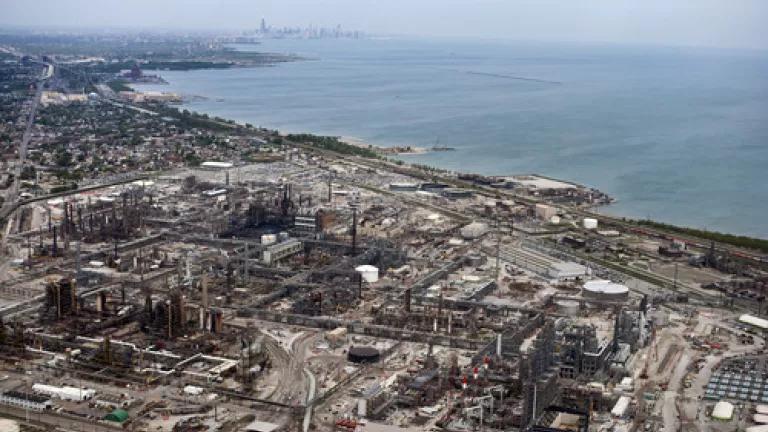
In an excellent investigative piece in the Chicago Tribune yesterday, environmental journalist Mike Hawthorne presented the weight of evidence that BP is polluting Lake Michigan with mercury. Specifically, according to the Trib, the evidence weighs about two pounds a year. That’s the amount of mercury that BP’s Whiting, Indiana refinery has at times been discharging into the Lake. If you don’t think that sounds like a lot, keep in mind that 1/70th of a teaspoon of mercury can make the fish in a 25 acre lake unsafe to eat. It is really, really toxic stuff – particularly for children and developing fetuses, for whom it can cause severe neurological damage.
The Indiana Department of Environmental Management (IDEM) is in the process of renewing BP’s wastewater permit – the first renewal since the controversial 2007 permit addressing BP’s plans to ramp up processing of dirty tar sands crude. As explained in the Tribune piece and in our comments submitted earlier to IDEM, the revised permit needs to be a lot clearer about setting hard deadlines for implementing the technology tested by Argonne National Laboratory, which so far has been working swimmingly in pilot tests. While we don’t have a problem with one last round of testing – the Argonne researchers specifically recommended that – there are no indications in the previous research results of any likely problems with the technology. The primary issue that Argonne wants studied in the next pilot test is options for handling waste streams from the process – which is important, but doesn’t suggest any issues with the process itself.
IDEM officials have acknowledged weaknesses with the permit, and indicated a willingness to revise it to address the problems we’ve highlighted. We’re cautiously optimistic that they mean business about fixing the permit and keeping mercury out of our Lake. We’ll find out whether our optimism is justified when we see the final permit.
The real scandal, though, is how we ever got to a place where BP is allowed to discharge such massive amounts of toxic mercury when the Clean Water Act – and BP’s last permit – set the appropriate limit for the Great Lakes at a tiny fraction of that amount. The law sets the standard for mercury in the Lakes 1.3 parts per trillion. BP was given 5 years in its 2007 permit – the one that provoked massive controversy in the region – to come into compliance with it. However, to the surprise of absolutely no one who was watching the situation, BP in the interim took advantage of a massive loophole. Indiana law allows BP to monitor its mercury discharge for two years, pick the very highest mercury hit over that entire time period, and then use that hit – get this – as its average limit over the course of a year in a permit variance. Think about that. They get to pick their very worst mercury day in two years, and then that’s not even the highest amount they’re allowed to discharge. They can discharge a whole lot more than that, so long as over the course of a year it all averages out to that highest hit. If you told industry to write its own regulations, that’s pretty much what you’d get. You can almost envision them laughing over the drafts.
And that’s how BP came to get a permit variance, over our protests, allowing it to discharge nearly 20 times the Great Lakes standard. In their two years of monitoring, they got one hit of 23.1 parts per trillion – which was an outlier, way higher than their other samples. And under the truck-sized loophole in Indiana law, IDEM gave it to them as their average.
So then we have to ask, how did that loophole come to be? The problem is that the stringent Great Lakes mercury standard was put in place a number of years ago based on improvements in the late ‘90s in our ability to detect mercury, which had actually outpaced our ability at that time to remove mercury from waste streams. Something did have to be done back then to allow the technology to catch up, but that’s where things went wrong. A basic and important feature of the Clean Water Act is that it requires constant ongoing evaluation of improvements in pollution control technology, and requires that those improvements be implemented whenever they’re available. But instead of requiring that here, IDEM developed its variance loophole based on a flawed late ‘90s study in Ohio purporting to show that mercury removal was cost-prohibitive. The effect was to freeze that study’s conclusions in time, and eliminate any requirement of ongoing technology study and implementation.
It’s fortunate, then – and to the credit of all those who pressured BP over their 2007 permit – that BP agreed to work with Argonne to develop new mercury removal technology. It’s also fortunate that EPA decided to update the Ohio study, with the results now out in draft. What’s desperately needed now is a permit requirement that undoes the damage of IDEM’s misguided variance by very specifically requiring implementation of modern mercury control technology as soon as it is confirmed to be feasible at the Whiting refinery – which everyone expects will be pretty soon. The draft permit has a loosely-worded general requirement that new technology be implemented at some unspecified point in the future. But this is no time for loosely-anything. Not when our treasured Lake, a source of drinking water for millions, is being poisoned on a daily basis.
Image © J Henry Fair 2013, www.IndustrialScars.com / Flight provided by LightHawk, www.LightHawk.org

